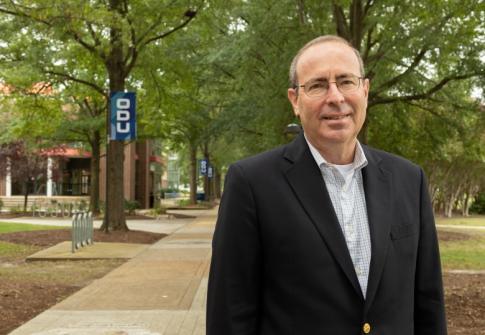Tom Barkin visited campus on Sept. 21.
By Joe Garvey
Richmond Fed President and CEO Tom Barkin told viewers of a virtual discussion hosted by Old Dominion University's Strome College of Business on Sept. 21 that once we can put the coronavirus behind us, "there's untapped consumption which could give the economy a real lift."
Barkin spoke to ODU faculty, staff and students as part of the Richmond Fed's "Around Our District" tour. He also met separately with business students during a visit to campus. Bob McNab, economics professor and director of the Dragas Center for Economic Analysis and Policy, moderated Barkin's discussion.
While admitting that the country is wracked by political, fiscal and virus uncertainty, Barkin said he's watching five key areas that could impact an economic recovery:
Infection rate: Barkin said he focuses on the rolling seven-day average. The infection rate jumped to 67,000 a day by late July and as of mid-September, it was at 39,000 - which is still higher than it was in April. Though hospitalizations and death rates are down, "as long as you have elevated infection rates you have a problem, which is that it creates uncertainty for businesses and whether they're going to invest and hire," he said. "And because it creates uncertainty for governments."
Initial jobless claims: Before the pandemic, they averaged 200,000 a week. Last week's number was 893,000, which is higher than the previous historical peak of 695,000. "They've remained stubbornly high six months after we shut everything down," he said. "If we continue to have high rates of initial unemployment claims, then it's going to be very hard to get to where we were from a labor market standpoint."
Labor force participation: The current rate is 61.7%, which is 1.7% below what it was in February. The drop during the downturn is not unexpected. "But is it going to bounce back the way it normally does?" he asked. "Are people going to leave the workforce because they've got to take care of their kids, or take care of their parents? Are Baby Boomers going to leave the workforce because of elevated health risk? I see that retirement as a source of leaving the workforce has escalated significantly. If we don't have strong participation by caregivers, by people over 55, our recovery is going to be limited by our inability to get workers. And strangely, in an economy where we have 8.4% unemployment, I talk to people in manufacturing and technology and health care who still can't find employees."
Savings rate: Because of stimulus payments, shutdowns and people limiting activities like dining out and traveling, the rate jumped from about 8% in February to 34% in April and is still about 18% today. "That's a lot of money in people's pockets that could still get spent if and when the economy comes back," he said.
Inflation: The Fed's target is 2%; the current rate is 1.3%. "But you could imagine inflationary scenarios, say if we get a vaccine and the economy comes roaring back," he said.
Among other topics, he also discussed the ramifications of the federal deficit, which will exceed $3 trillion this year. Barkin noted that debt as a percentage of Gross Domestic Product (GDP) was 38% in 2007 but is likely to exceed 100% this year - the largest it's been in history. He said now is not the time to address this issue. But at some point, our creditors could demand payment, which could cause interest rates to spike and a serious disruption to our economy.
This isn't an impossible problem to solve, he said, citing an exercise from the Today show eight years ago that brought together a diverse group of citizens who balanced the budget in 20 minutes.
"But I don't yet see any political will to do it," he said. "And so I fear that where we are is in a situation that's going to continue to escalate until we choose to do something about it."
To see a recording of Barkin's presentation, go to this link.




